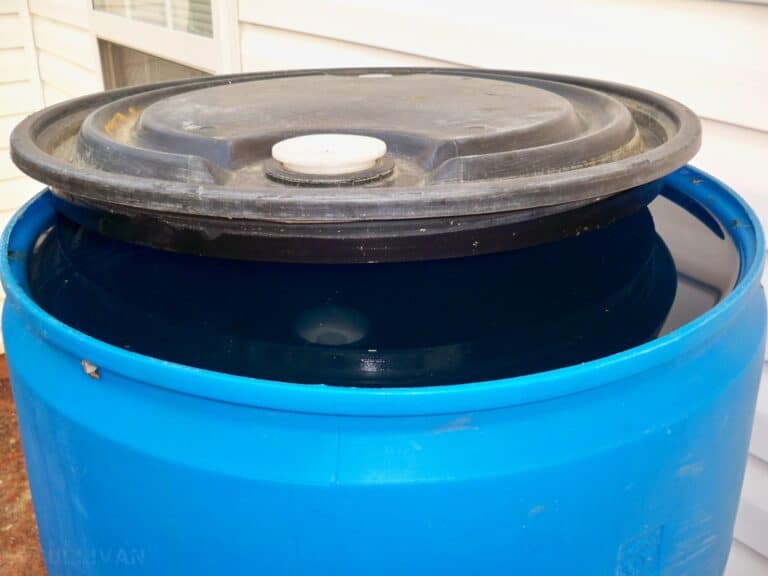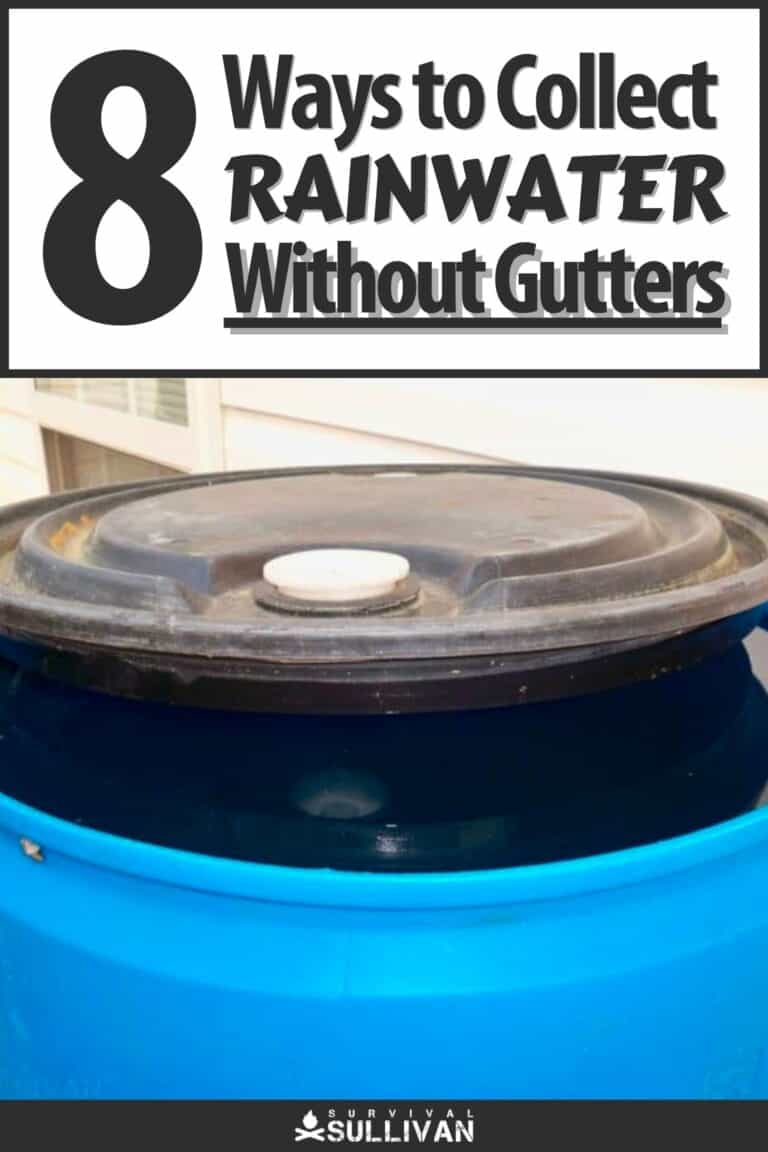Ask any prepper and they’ll probably tell you that the single most important resource you can have is water.
I would argue that it’s air, but I’m just being pithy; there’s really no shortage of air in most circumstances, but you can certainly run out of water! Once that happens, you’re probably only days away from death.

the top of a blue rain barrel filled with water
Accordingly, one of the best things you can do to ensure continuous access to water even during times of trouble is to collect rainwater.
But that typically requires that you have gutters set up on your home and connected to a catchment system.
That takes a little bit of money and know-how, and what if you don’t even have a house to hang those gutters on?
There are other ways to harvest it, no gutters required. Below I will tell you about 8 tried and true methods for catching lots of rainwater that you can repurpose for all of your needs.
1. Catch Runoff in Barrels or Tanks Directly
Sometimes it’s easy to overlook the obvious solution to a problem. Just because you don’t have gutters on your home, or any other structure, doesn’t mean you can’t catch rainwater flowing off the roof!
The water that hits your roof has to go somewhere. If you pay attention to the roof of your home and the roofs of any other structures on your property, you’ll probably notice that you’ll have great sheets or torrents of water cascading off at various points.
If you want to capture this water, all you need to do is place a rain barrel or other sizable container beneath it.
Just as simple as that, and you can still make use of the usual screens to block debris and also connect multiple barrels in sequence if you wish. No gutters needed!
Now, this method isn’t as efficient as using gutters routed to the same containers because it necessarily some of the water will go uncaught. Nonetheless, it’s still an entirely viable solution for most of us…
[TAG1]
2. Tarps
One of the simplest, most straightforward and also most effective ways to catch lots of rainwater is to use a tarp. The great thing about tarps is that you have many options to employ them depending on your needs.
It is possible to rig up a tarp using poles or stakes in order to suspend it over a tank or other large container, and then by poking a hole in the middle of it, over the inlet of the container you can drain water directly into it.
Another method is to arrange a tarp on the ground into a sort of low-lying container. You can use any depression in the ground, a container, or other materials with the tarp as a liner to hold the water.
This is an especially good technique if you need to start collecting rainwater in a hurry, lacking a better method.
Simply get the largest waterproof tarp that you can, raise and secure the edges, and reinforce the sides to contain the water that you catch. At the very least, this will buy you time to properly collect and store the captured rainwater.
3. Kiddie Pools
You don’t need to overcomplicate things: nearly any container capable of holding water can be used to collect rainwater on an ad hoc basis, and some of the best containers for our purposes are designed to hold water for other purposes!
Similar to using a tarp above, this is one of the most straightforward and simplest methods for catching rainwater.
Putting out kiddie pools- either larger backyard “wading” pools or the small, injection molded plastic ones- can catch many gallons of rainwater.
They are especially good at holding dozens of gallons of water, and are easy to place and fill.
This is one of my favorite impromptu containers to use in conjunction with tarps for catching truly massive amounts of rainwater.
Although they aren’t the most durable containers, especially the inflatable ones, with a little bit of care, they will hold up and can again buy you time to collect and store your water in a proper tank.
[TAG2]
4. Ponds
Ponds have been used throughout history for mass water storage, and the replenishment of ponds by rainfall has been pivotal for farmers, ranchers, and other property owners pretty much forever.
If you have a pond on your property, it is possible to use the water it contains for a variety of purposes so long as it is adequately treated.
If you want to use it for drinking or other potable purposes, it will require substantial filtration and subsequent purification, but it can be done.
Something else to consider is that it’s entirely possible to put in a much smaller, simpler pond yourself specifically for the purposes of collecting rainwater.
You can use a pond or pool liner to dig a relatively shallow but wide depression on your property that will work wonderfully to hold rainwater temporarily.
Yes, it’s prone to contamination and evaporation alike, but it is better to have it and be forced to process it than to not have it at all.
Also, a quick cautionary note: in many jurisdictions around the country the installation of a pond, even a small rain pond or fish pond, is regulated and will require permitting at the least.
Make sure you check in with your local authorities and your HOA, if you have one, before you start digging!
Of course, if you’re dealing with the aftermath of a major catastrophe and the rule of law is shaky at best, do whatever you must to ensure your own survival.
5. Build a Rain Collector
If, for whatever reason, you don’t have any gutters on your home (or you don’t have a home at all) and want to set yourself up for success by collecting tons of rainwater reliably, you should build a rain collector.
This is a purpose-made structure that’s designed to do exactly what it says. Generally, they sort of look like a raised sunshade or pergola; think a shed with no walls.
There are many different designs out there, and most of them easy enough to build yourself if you are crafty or have construction experience.
All are intended to be wide enough to catch a significant amount of rain and shaped to direct that rain to one or more collection points.
One of the most popular is a simple, single-panel roof that slopes down to a trough on one side; all of the rain that cascades off this service will fall into the trough.
Other, arguably better rain catchers include the butterfly style which has two angled surfaces that meet at a low point in the middle, sloping to one or both sides into a collection barrel or tank.
Another is the umbrella-style collector, named because it looks like an inverted umbrella.
Usually made with soft materials like a tarp or plastic sheeting, but some are made with tightly-joined planking. Both basically act like a giant funnel to direct your rain to a central point.
Any or all of them could work for you depending on your situation and your skills.
6. Collect Rainwater from the Ground
As silly as it sounds, it’s entirely possible to collect rainwater after it has hit the ground.
If you understand which way the water flows on your property, or the predominant direction that flows in the surrounding area, you can line the ground with concrete, stones or even gravel to help direct the flow of the water downhill to a container that is below ground or, potentially, above ground if you arrange a short drop for the water.
Although it sounds like an improvised solution, surface collection of rainwater has been used since antiquity in many different contexts around the world, and it’s still just as viable today.
But, as you might be expecting, filtration and purification of the rainwater is important if you’re going to use it for any potable purpose.
If you live in a hilly area or on the side of a slope, this is one of the best possible ways to catch rainwater assuming you can take care of any debris that might be coming along with it.
7. Buckets and Other Containers
If you’re completely unprepared to catch rain, but you need to catch rain straight away, you can use any container close at hand that will hold water.
Use buckets, plastic storage containers, plastic bottles, clean plastic food containers, anything. Absolutely anything that will hold water without grossly contaminating it is on the table, even an open, upside-down umbrella.
When I refer to contamination in this context, I’m talking about any containers that might be contaminated with chemical residues that cannot be easily treated through filtration or other purification methods.
If that rain is coming and you need water desperately, head outside and place these containers and areas where they will easily collect runoff or other substantial streams of water.
You can carry these containers to a larger collection surface or container, even your bathtub, to maximize your gains.
[TAG3]
8. Rain Collection Basin
If you are a little more DIY-inclined, you might consider building a rain collection basin. This is an inground or semi-above-ground container for holding rainwater, one that’s typically fed on two or more sides by sloped surfaces that funnel rainwater directly into it.
This is another method that has been used since time immemorial and was particularly popular for keeping livestock water containers full in ancient days.
You can easily create something like this using other methods we’ve mentioned on this list, or any waterproof materials that you might have handy.
An old bathtub basin or a livestock trough, can make the perfect basis for your own DIY basin, though you can go really old school and fashion one from stone if you are skilled (and dedicated!) enough.

The post Harvesting Rainwater: 8 Ways to Collect it Without Gutters appeared first on Survival Sullivan.
By: Tom Marlowe
Title: Harvesting Rainwater: 8 Ways to Collect it Without Gutters
Sourced From: www.survivalsullivan.com/collect-rainwater-without-gutters/
Published Date: Thu, 07 Sep 2023 16:00:00 +0000
------------------------
Did you miss our previous article...
https://bushcrafttips.com/bushcraft-news/gearing-up-for-adventure-unpacking-the-backcountry-skills-summit-experience
 What is BushcraftSurvival SkillsToolsVideosBushcraft CampsBushcraft KitsBushcraft ProjectsPrivacy PolicyTerms And Conditions
What is BushcraftSurvival SkillsToolsVideosBushcraft CampsBushcraft KitsBushcraft ProjectsPrivacy PolicyTerms And Conditions
